#36 in a series of articles about the technology behind Bang & Olufsen loudspeakers
“In all affairs it’s a healthy thing now and then to hang a question mark on the things you have long taken for granted.”
-Bertrand Russell
If you were to get your hands on Harry Potter’s invisibility cloak and you were to walk into the acoustics department at Bang & Olufsen and eavesdrop on conversations, you’d sometimes be amazed at some of the questions we ask each other. That’s particularly true when we’re working on a new concept, because, if the concept is new, then it’s also new for us. The good thing is that all of my colleagues (and I) are ready and willing at any time to ask what might be considered to be a stupid (or at least a very basic) question.
One of those questions that we asked each other recently seemed like a basic one – why do we always put the tweeter on the top? It seems like there are very few loudspeakers that don’t do this (of course, there are exceptions – take the BeoLab Penta, for example, which has the tweeter in the middle). However, more often than not, when we (and most other people) make a loudspeaker, we put the loudspeaker drivers in ascending order of frequency – woofers on the bottom, tweeters on the top. Maybe this is because woofers are heavier, and if you stand a BeoLab 5 on its head, it will fall over – but that’s not really the question we were asking…
The REAL question we were asking ourselves at the time was: if we were to build a multi-way loudspeaker – let’s say a 3-way, with a woofer, a midrange and a tweeter, and if the crossovers were such that the bulk of the “interesting” information (say, the vocal range) was coming from the midrange, then why would we not put the midrange at ear height and put the tweeter between it and the woofer? For example, imagine we made BeoLab 20 without an Acoustic Lens on top, would it be better to arrange the drivers like the version on the left of Figure 1 or the version on the right? Which one would sound better?
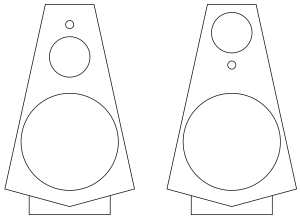
After answering that question, there’s a second question would follow closely behind: how close together do the drivers with adjacent frequency bands (i.e. the woofer and the midrange or the tweeter and the midrange) have to be in order for them to sound like one thing? Of course, these two questions are inter-related. If your midrange and tweeter are so far apart that they sound like different sound sources, then you would probably be more interested in where the voice was coming from than where the cymbals were coming from…
Of course, step one in answering the second question could be to calculate/simulate the response of the loudspeaker, based on distance between drivers, the crossover frequency (and therefore the wavelengths of the frequency band we’re interested in), the slopes of the crossover filters, and so on. It would also be pretty easy to make a prototype model out of MDF, put the loudspeaker drivers in there, do the vertical directivity measurements of the system in the Cube, and see how well the theory matches reality.
However, the question we were really interested in was “but how would it sound?” – just to get a rough idea before going any further. And I have to stress here that we were really talking about getting a rough idea. What I’m about to describe to you is a little undertaking that we put together in a day – just to find out what would happen. This was not a big, scientifically-valid experiment using a large number of subjects and intensive statistics to evaluate the results. It was a couple of guys having a chat over coffee one morning when one of them said “I wonder what would happen if we put the midrange on top…” and then, off they went to a listening room to find out.
One thing we have learned in doing both “quick-n-dirty” listening comparisons and “real, scientifically valid listening tests” is that the placement of a loudspeaker in a room, has a huge effect on how the loudspeaker sounds. So, when we’re comparing two loudspeakers, we try to put them as close together as possible. So, we tried different versions of this. In the first, we took two pairs of loudspeakers, and put the left loudspeakers in each pair side-by-side, with one pair upside down and the other right-side up, as shown in Figure 2.

We then switched between the right-side up pair and the upside down pair, listening for a change in vertical position of the image. Note that we tried two arrangements of this – one where both right-side up loudspeakers were to the left of the upside-down loudspeakers. The other where the “right-side up” loudspeakers were the “outside” pair, as shown in Figure 3.

There are advantages and disadvantages of both of these arrangements – but in both cases, there is a lateral shift in the stereo image. When switching between pairs, either you get a left-right shift in image, or a change in width… It turned out that this change was more distracting than the vertical arrangement of the drivers, so we changed configuration to the one shown in Figure 4, below.
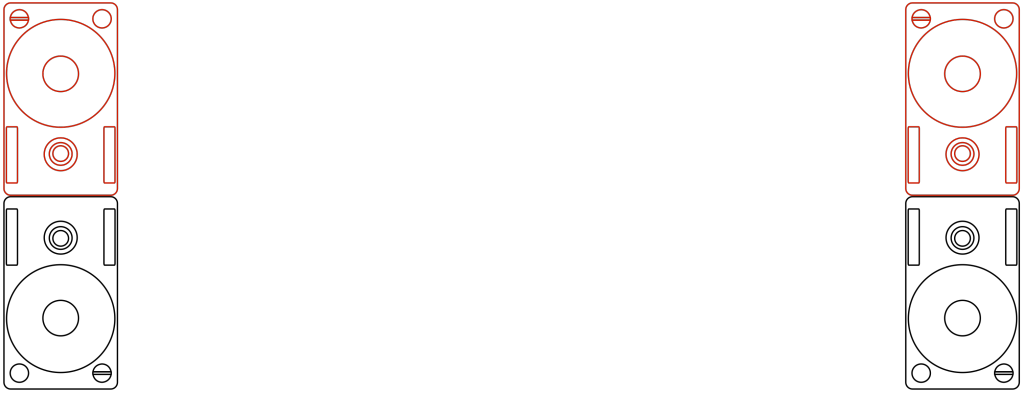
Now, instead of switching between loudspeakers, we pretended that one of them was a tweeter and other was a mid-woofer, and switched which was which, on the fly. Our “virtual” crossover was close-ish to the real crossover in the loudspeakers (our crossover was at 3.5 kHz, if you’re curious), so you could say that we were sort-of changing between using the upper tweeter + the lower woofer and using the upper woofer + lower tweeter, the “acoustical centres” of which are roughly at the same height. (remember – this was a quick-n-dirty experiment…)
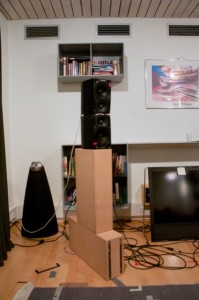
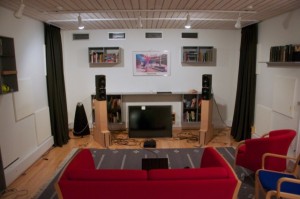
After having listened to these three configurations of loudspeakers, we decided that the vertical arrangement of the drivers was not important with the vertical separation we were using.
This brought us to the second part of the question… If the tweeter and the midrange were further apart, would we have a preference? So, we kept our virtual crossover, using one loudspeaker as the “tweeter” and the other as the “mid-woofer”, and we moved the loudspeakers further apart, one example of which is shown in Figure 7. (One thing to note here is that when I say “further apart” I’m talking about the separation in the vertical angles of the sources – not necessarily their actual distance from each other. For example, if the loudspeakers were 1 m apart vertically, and you were level with one of the loudspeakers, but the listening position was a kilometre away, then the vertical angular separation (0.057 degrees) would be much smaller than if you were 1 m away (45 degrees)…)
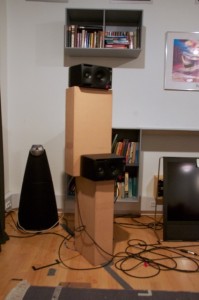
The answer we arrived at at the end was that, when the vertical separation of the drivers gets extreme (perhaps I should use the word “silly” instead), we preferred the configuration where the “mid-woofer” was at ear-height. However, this was basically a choice of which version we disliked less (“preference” is a loaded word…). When the drivers get far enough apart, of course, they no longer “hang together” as a single device without some extra signal processing tricks.
So, we went to lunch having made the decision that, as long as the tweeters and the midranges are close enough to each other vertically, we really didn’t have a preference as to which was on top, so, if anyone asked, we would let the visual designers decide. (Remember that “close enough” is not only determined by this little experiment – it is also determined by the wavelengths of the crossover frequencies and whether or not there are more drivers to consider. For example, in the example in Figure 1, it might be that we don’t care about the relative placement of the tweeter and midrange in isolation – but perhaps putting the tweeter between the midrange and woofer will make them too far apart to have a nice vertical directivity behaviour across the lower crossover…)
Addendum
This isn’t the first time we asked ourselves such a question. Although I was not yet working at B&O at the time, my colleagues tell me that, back in the days when they were developing the BeoLab 3500 and the BeoLab 7-1 (both of which are “stereo” loudspeakers – essentially two multi-way loudspeakers in a single device) , they questioned the driver arrangement as well. Should the tweeters or the midranges / woofers be on the outside? You can see in the photos of the 3500 on this page that they decided to put the lower-frequency bands wider because the overall impression with stereo signals was wider than if the tweeters were on the outside.
Millemissen says:
I have always thought, that the ‘basic’ answer to the ‘basic’ question on the placement of the tweeter would be:
You have to place the tweeter i earheight!
But – alas – now I see, that it is not as simple as that.
Jeff says:
Interesting experiment, with results that aren’t unexpected IMO. I still have my pair of DCM Time Windows I purchased new in 1979, they have the mid/woofers at ear level with the tweeters below, I think they were trying to “time align” the drivers, at least according to their literature of the time, though control of lobing and first floor bounce probably entered into it. I’ve never measured them.
geoff says:
Hi Jeff,
To be honest, we weren’t that surprised either. But, like it says in the quote I started with, it’s good to go back and ask some basic questions now and again.
Cheers
-geoff
geoff says:
Hi MM,
There is an additional factor that may complicate things – this is the apparent height of phantom images with changes in the level of the sidewall reflections. Many people I have spoken with who have listened to a stereo recording in an anechoic chamber talk about the phantom image having a “rainbow” shape, where the centre images are higher than the loudspeakers. My experience matches this, both with listening in anechoic conditions and with narrow-directivity loudspeakers.
I’ve never seen a “real” listening test done to find out whether there is a correlation between sidewall reflections and phantom image height – but it would certainly make for an interesting study in my opinion. The results would then (possibly) lead towards some recommendations on loudspeaker driver height…
Cheers
/geoff
John says:
Hi Geoff; very interesting experiment indeed, and as always thanks so much for your exceptionally interesting articles. Years ago I owned a pair of B&W DM2a’s which featured an ‘upside down’ speaker layout with woofer at the top, tweeter below etc, however this was mainly because of it’s transmission line enclosure. Whether there was any sonic advantage to this driver layout, I could not say. Lovely speakers though, especially with vinyl recordings of the day…
geoff says:
Hi John,
Thanks for your kind words. Your comment about the DM2a’s made me think of one additional effect of putting the high-frequency drivers on the bottom. Since they’re closer to the floor, this means that the comb filter caused by the interaction between the direct sound and the floor reflection will be pushed higher in frequency. At an extreme case, if the driver is at floor level, then the comb filter is pushed up to infinity Hz (assuming a point-source driver, of course…). This might be preferable to the effect on the perceived height of the stereo images. Of course, another solution is to put carpet on the floor…
Cheers
– geoff
Jeff says:
Geoff,
You’re absolutely right of course! Always good to go back and reconfirm your impressions about things, and it sounds like a good experiment for doing just that. Sometimes you can surprise yourself though, so always worth a bit of time playing around.
One of these days I need to pull my old Time Windows out and see how they sound, after 30 years of not hearing them. I seriously doubt they will compare with my BL9s though, if they do I’m going to be very upset.
Regarding experimentation and such, it seems, looking all the way back to the phase link Beovox line in the 70s, that B&O have been both aware of and addressed in design such things as power response far before many companies did, and a lot of alleged high end speakers still fall short IMO in this. So much for the old trope of B&O being just a pretty face.
Kerry says:
There is something else that flipping the vertical alignment does. It can alter the vertical off-axis nulls, which may or may not make much of a difference depending on crossover slopes and frequencies between the two drivers. In some cases, it can be beneficial because you will have the broad lobe pointed up slightly, so you don’t lose much treble as you stand up. This can be important for people who like to walk around while listening.
geoff says:
hi Kerry,
That’s true in a system with a some traditional analogue crossovers, but with a DSP-based crossover, things are more controllable…
Cheers
/geoff